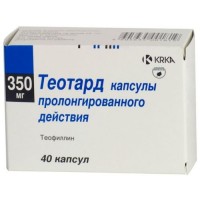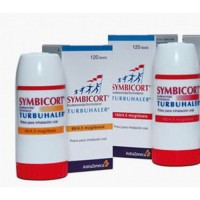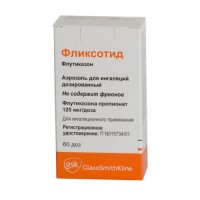Symbicort Turbuhaler 80 / 4.5 mcg 60 doses metered powder for inhalation
- $85.10
Sku:
3a3b35efc671
Brand:
AstraZeneca (Sweden)
Simbikort TurbuhalerMezhdunarodnoe name:
Formoterol + Budesonid (Formoterol+Budesonide) Group accessory:
Bronkhodilatiruyushchy means (beta2-adrenomimetik selection + glucocorticosteroid local)
Description of active ingredient (MNN):
Formoterol + BudesonidLekarstvennaya form:
powder for inhalations dozirovannyypharmakologichesky action:
The combined broncholitic means containing GKS for topical administration and a selection beta2-adrenostimulyator showing additive effect concerning decrease in frequency of exacerbations of bronchial asthma. Budesonid - inhalation GKS, in the recommended doses has anti-inflammatory effect (has the smaller frequency of side effects, than system GKS). Formoterol - the selection agonist of beta2-adrenergic receptors causing relaxation of smooth muscles of bronchial tubes in patients with reversible obstruction of airways. Broncholitic action comes quickly, within 1-3 min. after inhalation, and remains during 12 h after inhalation of a single dose. Addition of a formoterol to a budesonid reduces expressiveness of symptoms of bronchial asthma, improves function of bronchial tubes and reduces the frequency of exacerbations of a disease. Influence on function of bronchial tubes corresponds to that a combination of monodrugs of a budesonid and a formoterol and exceeds action of one budesonid. Drug has good tolerance. Indications:
The bronchial asthma (which is insufficiently controlled by reception of inhalation GKS and beta2-adrenostimulyator of short action or adequately controlled by inhalation GKS and beta2-adrenostimulyator of long action). Contraindications:
Hypersensitivity to a budesonid, a formoterol or lactose. Children's age (up to 12 years). With care. Pregnancy, the lactation period, a pulmonary tuberculosis, fungal, viral or bacterial infections of respiratory organs, a thyrotoxicosis, a pheochromocytoma, diabetes, an uncontrollable hypopotassemia, GOKMP, heavy arterial hypertension, aneurysm, an ischemic heart disease, a tachyarrhythmia, dekompensirovanny HSN, the extended action Q-T.Pobochnye interval:
Frequent (more than 0.01%): headache, tachycardia, tremor, candidiasis and irritation of a mucous membrane of a stomatopharynx, cough, hoarseness. Less frequent (0.01-0.001%): myotonia, excitement, concern, nausea, dizziness, sleep disorders. Rare (less than 0.001%): dieback, urticaria, itching, bronchospasm. Very rare: budesonid - a depression, a behavior disorder (mainly at children), system side effects of GKS (suppression of function of adrenal glands, a growth inhibition at children and teenagers, decrease in bone mineral density, a cataract and increase in intraocular pressure), reactions of hypersensitivity of the immediate or slowed-down types (including dermatitis, a Quincke's disease and a bronchospasm), appearance of bruises and 'bruises'. Formoterol - stenocardia, a hyperglycemia, change of taste, lability of the ABP, a paradoxical bronchospasm, arrhythmia, fibrillation of auricles, supraventricular tachycardia and premature ventricular contraction. Overdose. Symptoms: tremor, headache, heartbeat and tachycardia, decrease in the ABP, metabolic acidosis, hypopotassemia and hyperglycemia. At long reception of overdoses - systemic action of GKS (hypercorticoidism and suppression of function of adrenal glands). Treatment: symptomatic. Route of administration and doses:
It is inhalation. Selection of a dose is made individually and depends on disease severity. Adults and children are more senior than 12 years: when using the powder for inhalations containing budesonid and formoterol in the ratio 80 mkg / 4.5 mkg/dose - 1-2 inhalations 2 times a day, 160 mkg / 4.5 mkg/dose - 1-2 inhalations 2 times a day. After achievement of optimum control of symptoms of bronchial asthma against the background of prescribing of drug 2 times a day are possible a dose decline to the smallest effective. Special instructions:
The powder for inhalations containing budesonid and formoterol in the ratio 80/4.5 mkg / a dose is not shown to patients with heavy bronchial asthma. Does not intend for initial selection of therapy at the first stages of treatment of bronchial asthma. The gradual dose decline of drug before the treatment termination is recommended. Increase in frequency of intake of bronchodilators for emergency aid indicates deterioration in a course of a basic disease and forms the basis for revision of tactics of treatment of bronchial asthma. For minimization of a possibility of development of a fungal infection of a stomatopharynx it is necessary to rinse a mouth water after each inhalation. There are no data on use of drug for stopping of bad attacks of bronchial asthma. Patients should strictly recommend all the time to have at themselves HP for emergency aid. Treatment should not be begun during exacerbation of bronchial asthma. As well as at any other inhalation therapy the emergence of a paradoxical bronchospasm is possible (in this case it is necessary to reconsider tactics of treatment and if necessary to appoint alternative therapy). Manifestation of systemic action when performing inhalation therapy is less probable, than when using oral GKS. However it can be shown at reception of any inhalation GKS, especially when using high doses during the long span (it is very important to use the smallest effective dose of inhalation GKS which provides optimum control of symptoms of bronchial asthma). Doctors need to watch carefully growth of children and teenagers who it is long accept GKS in any dosage form and to estimate a ratio of advantage of therapy of GKS and possible risk of a growth inhibition. If against the background of the previous system therapy of GKS the function of adrenal glands was broken, it is necessary to take precautionary measures at transfer of patients to inhalation drug treatment (at the patients stopping therapy by oral GKS the insufficient function of adrenal glands can remain for a long time). In stressful situations it is always necessary to remember a possibility of residual dysfunction of adrenal glands at such patients. There are no clinical data on use of drug or sharing of a formoterol and budesonid during pregnancy. At pregnant women it is necessary to use drug only if the expected advantage for mother exceeds potential risk for a fruit, at the same time it is necessary to use the smallest effective dose of a budesonid necessary for maintenance of adequate control of symptoms of bronchial asthma. It is not known whether gets formoterol or budesonid in breast milk of women (drug can be appointed to the feeding women, only if the expected advantage for mother is more, than any possible risk for the child). During treatment it is recommended to control concentration of K+ in blood serum and also glucose at the patients having diabetes. Contains lactose (less than 1 mg / a dose). Usually such quantity does not cause problems in patients with a lactose intolerance. Interaction:
Reception of 200 mg of a ketokonazol increases concentration in plasma of orally accepted budesonid in a dose of 3 mg on average by 6 times once a day. When assigning a ketokonazol in 12 h after reception of a budesonid the concentration of the last in plasma increases by 3 times. Information on similar interaction with an inhalation budesonid is absent, however it is necessary to expect noticeable increase in concentration of drug in plasma (if it is impossible to exclude a similar combination, an interval between purpose of a ketokonazol and a budesonid it is necessary to increase or lower as much as possible doses of a budesonid). Other CYP3A4 inhibitors probably can also increase considerably concentration of a budesonid in plasma. Blockers of beta and adrenergic receptors (including in the form of eye drops) weaken action of a formoterol. Quinidine, Disopyramidum, procaineamide, fenotiazina, antihistaminic HP (terfenadin), MAO inhibitors and tricyclic antidepressants increase risk of development of lengthening of an interval of Q-T and ventricular arrhythmias. The dopamine, sodium left thyroxine, oxytocin and ethanol reduce shipping of beta2-adrenostimulyator a myocardium. MAO inhibitors, furasolidone and Procarbazinum increase risk of increase in the ABP. Galogensoderzhashchy hydrocarbon HP for the general anesthesia increase risk of developing arrhythmias. Other beta adrenostimulyatory enhance severity of side effects of a formoterol. Derivatives of xanthine, the ISS, some diuretics, cardiac glycosides increase risk of development of a hypopotassemia.
To develop
Formoterol + Budesonid (Formoterol+Budesonide) Group accessory:
Bronkhodilatiruyushchy means (beta2-adrenomimetik selection + glucocorticosteroid local)
Description of active ingredient (MNN):
Formoterol + BudesonidLekarstvennaya form:
powder for inhalations dozirovannyypharmakologichesky action:
The combined broncholitic means containing GKS for topical administration and a selection beta2-adrenostimulyator showing additive effect concerning decrease in frequency of exacerbations of bronchial asthma. Budesonid - inhalation GKS, in the recommended doses has anti-inflammatory effect (has the smaller frequency of side effects, than system GKS). Formoterol - the selection agonist of beta2-adrenergic receptors causing relaxation of smooth muscles of bronchial tubes in patients with reversible obstruction of airways. Broncholitic action comes quickly, within 1-3 min. after inhalation, and remains during 12 h after inhalation of a single dose. Addition of a formoterol to a budesonid reduces expressiveness of symptoms of bronchial asthma, improves function of bronchial tubes and reduces the frequency of exacerbations of a disease. Influence on function of bronchial tubes corresponds to that a combination of monodrugs of a budesonid and a formoterol and exceeds action of one budesonid. Drug has good tolerance. Indications:
The bronchial asthma (which is insufficiently controlled by reception of inhalation GKS and beta2-adrenostimulyator of short action or adequately controlled by inhalation GKS and beta2-adrenostimulyator of long action). Contraindications:
Hypersensitivity to a budesonid, a formoterol or lactose. Children's age (up to 12 years). With care. Pregnancy, the lactation period, a pulmonary tuberculosis, fungal, viral or bacterial infections of respiratory organs, a thyrotoxicosis, a pheochromocytoma, diabetes, an uncontrollable hypopotassemia, GOKMP, heavy arterial hypertension, aneurysm, an ischemic heart disease, a tachyarrhythmia, dekompensirovanny HSN, the extended action Q-T.Pobochnye interval:
Frequent (more than 0.01%): headache, tachycardia, tremor, candidiasis and irritation of a mucous membrane of a stomatopharynx, cough, hoarseness. Less frequent (0.01-0.001%): myotonia, excitement, concern, nausea, dizziness, sleep disorders. Rare (less than 0.001%): dieback, urticaria, itching, bronchospasm. Very rare: budesonid - a depression, a behavior disorder (mainly at children), system side effects of GKS (suppression of function of adrenal glands, a growth inhibition at children and teenagers, decrease in bone mineral density, a cataract and increase in intraocular pressure), reactions of hypersensitivity of the immediate or slowed-down types (including dermatitis, a Quincke's disease and a bronchospasm), appearance of bruises and 'bruises'. Formoterol - stenocardia, a hyperglycemia, change of taste, lability of the ABP, a paradoxical bronchospasm, arrhythmia, fibrillation of auricles, supraventricular tachycardia and premature ventricular contraction. Overdose. Symptoms: tremor, headache, heartbeat and tachycardia, decrease in the ABP, metabolic acidosis, hypopotassemia and hyperglycemia. At long reception of overdoses - systemic action of GKS (hypercorticoidism and suppression of function of adrenal glands). Treatment: symptomatic. Route of administration and doses:
It is inhalation. Selection of a dose is made individually and depends on disease severity. Adults and children are more senior than 12 years: when using the powder for inhalations containing budesonid and formoterol in the ratio 80 mkg / 4.5 mkg/dose - 1-2 inhalations 2 times a day, 160 mkg / 4.5 mkg/dose - 1-2 inhalations 2 times a day. After achievement of optimum control of symptoms of bronchial asthma against the background of prescribing of drug 2 times a day are possible a dose decline to the smallest effective. Special instructions:
The powder for inhalations containing budesonid and formoterol in the ratio 80/4.5 mkg / a dose is not shown to patients with heavy bronchial asthma. Does not intend for initial selection of therapy at the first stages of treatment of bronchial asthma. The gradual dose decline of drug before the treatment termination is recommended. Increase in frequency of intake of bronchodilators for emergency aid indicates deterioration in a course of a basic disease and forms the basis for revision of tactics of treatment of bronchial asthma. For minimization of a possibility of development of a fungal infection of a stomatopharynx it is necessary to rinse a mouth water after each inhalation. There are no data on use of drug for stopping of bad attacks of bronchial asthma. Patients should strictly recommend all the time to have at themselves HP for emergency aid. Treatment should not be begun during exacerbation of bronchial asthma. As well as at any other inhalation therapy the emergence of a paradoxical bronchospasm is possible (in this case it is necessary to reconsider tactics of treatment and if necessary to appoint alternative therapy). Manifestation of systemic action when performing inhalation therapy is less probable, than when using oral GKS. However it can be shown at reception of any inhalation GKS, especially when using high doses during the long span (it is very important to use the smallest effective dose of inhalation GKS which provides optimum control of symptoms of bronchial asthma). Doctors need to watch carefully growth of children and teenagers who it is long accept GKS in any dosage form and to estimate a ratio of advantage of therapy of GKS and possible risk of a growth inhibition. If against the background of the previous system therapy of GKS the function of adrenal glands was broken, it is necessary to take precautionary measures at transfer of patients to inhalation drug treatment (at the patients stopping therapy by oral GKS the insufficient function of adrenal glands can remain for a long time). In stressful situations it is always necessary to remember a possibility of residual dysfunction of adrenal glands at such patients. There are no clinical data on use of drug or sharing of a formoterol and budesonid during pregnancy. At pregnant women it is necessary to use drug only if the expected advantage for mother exceeds potential risk for a fruit, at the same time it is necessary to use the smallest effective dose of a budesonid necessary for maintenance of adequate control of symptoms of bronchial asthma. It is not known whether gets formoterol or budesonid in breast milk of women (drug can be appointed to the feeding women, only if the expected advantage for mother is more, than any possible risk for the child). During treatment it is recommended to control concentration of K+ in blood serum and also glucose at the patients having diabetes. Contains lactose (less than 1 mg / a dose). Usually such quantity does not cause problems in patients with a lactose intolerance. Interaction:
Reception of 200 mg of a ketokonazol increases concentration in plasma of orally accepted budesonid in a dose of 3 mg on average by 6 times once a day. When assigning a ketokonazol in 12 h after reception of a budesonid the concentration of the last in plasma increases by 3 times. Information on similar interaction with an inhalation budesonid is absent, however it is necessary to expect noticeable increase in concentration of drug in plasma (if it is impossible to exclude a similar combination, an interval between purpose of a ketokonazol and a budesonid it is necessary to increase or lower as much as possible doses of a budesonid). Other CYP3A4 inhibitors probably can also increase considerably concentration of a budesonid in plasma. Blockers of beta and adrenergic receptors (including in the form of eye drops) weaken action of a formoterol. Quinidine, Disopyramidum, procaineamide, fenotiazina, antihistaminic HP (terfenadin), MAO inhibitors and tricyclic antidepressants increase risk of development of lengthening of an interval of Q-T and ventricular arrhythmias. The dopamine, sodium left thyroxine, oxytocin and ethanol reduce shipping of beta2-adrenostimulyator a myocardium. MAO inhibitors, furasolidone and Procarbazinum increase risk of increase in the ABP. Galogensoderzhashchy hydrocarbon HP for the general anesthesia increase risk of developing arrhythmias. Other beta adrenostimulyatory enhance severity of side effects of a formoterol. Derivatives of xanthine, the ISS, some diuretics, cardiac glycosides increase risk of development of a hypopotassemia.
To develop








